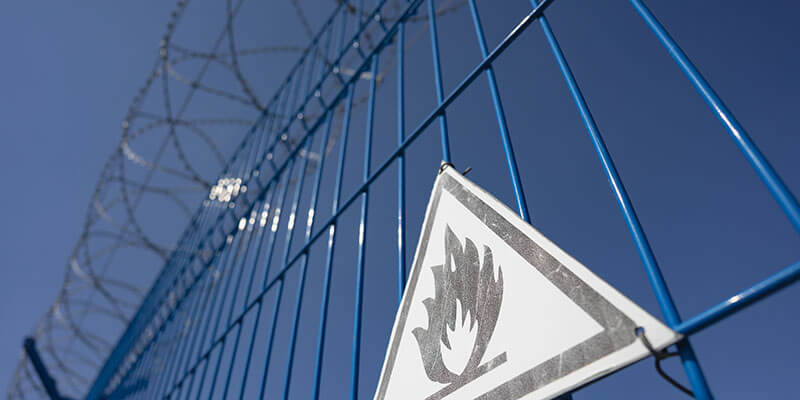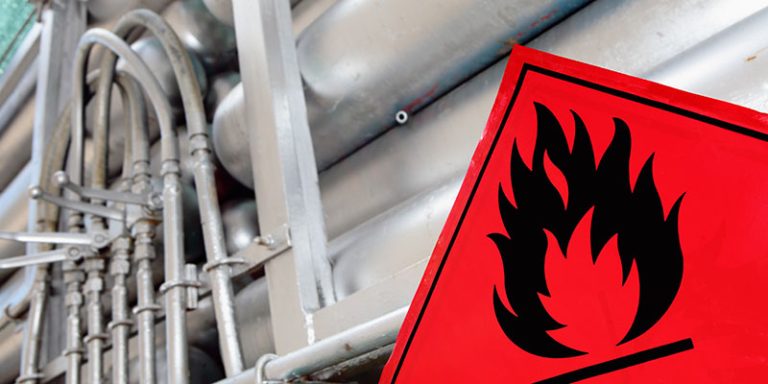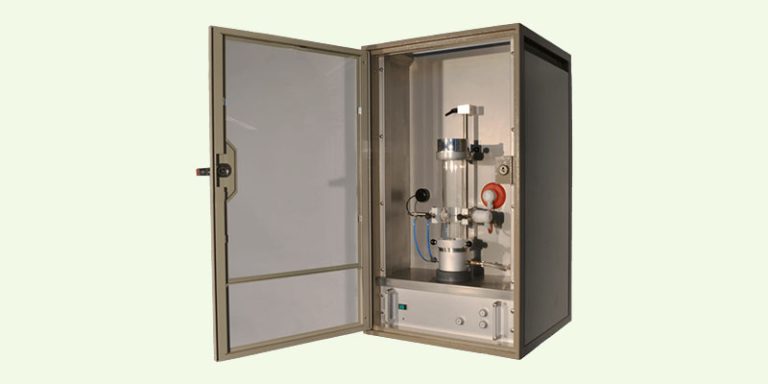An explosive atmosphere is a hazardous environment where a mixture of flammable substances, such as gases, vapors, mists, or dust, can combine with air under certain conditions, and ignite, resulting in an explosion. These substances, when mixed with air between specific percentage mixtures, can be ignited by excessive temperatures, arcs, or sparks, leading to rapid combustion and potential damage to property or personnel.
The term ATEX is often used to describe these explosive atmospheres, as it refers to the risks of such environments in the workplace. The primary concern in these situations is the prevention of accidents and injuries caused by ignition sources in areas where flammable substances are present. Understanding and identifying the factors that contribute to the formation of explosive atmospheres is crucial in order to establish safety measures and minimize risk.
Various industries, such as oil and gas, chemical processing, and manufacturing, can have areas classified as hazardous locations due to the presence of potentially explosive atmospheres. This classification is key for determining the appropriate safety standards, equipment, and procedures necessary to mitigate the risk of explosion in these environments.
Understanding Explosive Atmospheres
An explosive atmosphere is a hazardous environment where combustible substances are mixed with air under certain atmospheric conditions. These substances can include gases, vapors, mists, dusts, and fibers. The potential for combustion in such an environment is significantly increased when exposed to a source of ignition, leading to an explosion.
Gases, Vapors, and Mists
Explosive atmospheres can be created when flammable gases, vapors, or mists are mixed with air under certain conditions. Common flammable gases and vapors include gasoline, oil, acetone, alcohol, and other fuel-based substances. When these flammable materials are mixed with air in a specific proportion, they can form a highly combustible mixture. The lower explosive limit (LEL) is the minimum concentration of a gas or vapor in air that can ignite, while the upper explosive limit (UEL) is the maximum concentration beyond which the mixture will not ignite. Between these two limits lies the explosive range, in which any concentration of gas, vapor, or mist can ignite and result in an explosion (ExVeritas).
Combustible Dusts
Combustible dusts, such as those generated from the storage or processing of cereals, sugar, and other raw materials, can also create explosive atmospheres. These fine particles, when mixed with air, can be ignited by a source of ignition and cause an explosion. This is a significant hazard in industries such as distilleries, food storage, and agricultural facilities (Applus Laboratories).
Explosive Atmospheres and Oxygen Levels
One key factor affecting the formation of explosive atmospheres is the level of oxygen present in the environment. In general, higher oxygen concentrations increase the potential for combustion and explosions. However, some hazardous atmospheres may be oxygen-deficient, and introducing oxygen in these environments can also lead to a risk of explosion. This is why understanding the specific hazards associated with different combustible substances and maintaining appropriate oxygen levels is critical for preventing explosive atmospheres.
In conclusion, an explosive atmosphere is a dangerous environment where flammable substances, such as gases, vapors, mists, or dusts, are mixed with air under specific atmospheric conditions. These conditions can be influenced by factors such as temperature, pressure, and oxygen levels. Proper identification and management of explosive atmospheres is essential in preventing incidents and maintaining a safe workplace.
Sources of Ignition
An explosive atmosphere is a dangerous environment that can be triggered by various sources of ignition. These sources can be broadly classified into three categories: electrical equipment, heat and chemical reactions, and mechanical sparks. In this section, we will explore each of these ignition sources and their role in creating explosive atmospheres.
Electrical Equipment
Electrical equipment can serve as a significant source of ignition in explosive atmospheres. Components such as switches, transformers, and motors can generate sparks or heat, leading to the ignition of flammable gasses, vapors, mists, or combustible dust. Consequently, businesses operating in hazardous areas must take precautions to prevent electrical equipment from becoming ignition sources. This can be achieved through proper installation, maintenance, and use of certified(AT) equipment designed for hazardous environments.
Heat and Chemical Reactions
Heat generated by hot surfaces, such as those associated with friction, can lead to the ignition of explosive atmospheres (SpringerLink).
Additionally, chemical reactions can also generate heat, resulting in ignition of the surrounding environment. A reaction between certain chemicals, such as spontaneous combustion or exothermic reactions, can rapidly raise the temperature and ignite flammable substances in the atmosphere. Hence, it is crucial to properly store, handle, and manage hazardous materials to minimize the risk of heat-induced ignition.
Mechanical Sparks
Mechanical friction, such as that caused by moving machinery or metal-on-metal contact, can generate sparks capable of igniting an explosive atmosphere. Activities such as grinding, cutting, or drilling can create enough friction to ignite combustible materials, particularly dusts.
To mitigate this risk, it’s essential to establish strict operating procedures for mechanical equipment and enforce proper maintenance routines. Moreover, implementing targeted preventive measures, like using spark arrestors, can further reduce the possibility of mechanical spark-induced explosions.
Hazardous Area Classification and ATEX Zones
Understanding hazardous area classification is essential when working with or around an explosive atmosphere. The main purpose of this classification is to minimize the risk of explosion and ensure safety.
Zones and Divisions
Hazardous areas are classified into zones and divisions based on the level of risk and likelihood of an explosive atmosphere occurring. In general, they are divided into two primary groups depending on the presence of explosive gases, mists or vapors, and combustible dusts:
- Explosive Gas Atmospheres: Zone 0, 1, and 2
- Explosive Dust Atmospheres: Zone 20, 21, and 22
The most common values used for gas atmospheres are:
- Zone 0: Explosive atmosphere for more than 1000h/yr
- Zone 1: Explosive atmosphere for more than 10, but less than 1000 h/yr
- Zone 2: Explosive atmosphere for less than 10h/yr, but still sufficiently likely as to require controls over ignition sources
Employers must classify these areas and implement appropriate safety measures to ensure the protection of workers and equipment(HSE).
ATEX Directive
The ATEX Directive is a safety standard set by the European Union to regulate equipment and protective systems intended for use in potentially explosive atmospheres. ATEX stands for Atmosphères Explosibles and is derived from directives 2014/34/EU and 99/92/EC(ATEX Zone & Zoning).
The directive requires manufacturers to gain ATEX certification for their products if they are to be used in hazardous areas within the EU. This includes the products meeting specific safety requirements and being tested and certified by a Notified Body(What is Hazardous Area Classification?).
IECEx
IECEx is the International Electrotechnical Commission System for Certification to Standards Relating to Equipment for Use in Explosive Atmospheres. It is a global certification system that provides assurance that equipment and systems are manufactured and operated according to international safety standards(Emerson).
Unlike the ATEX Directive, which is limited to the EU, IECEx is recognized in many countries worldwide. This makes it an important certification for manufacturers looking to market their products internationally within hazardous industries(Emerson).
Regulations and Workplace Safety Measures
Dangerous Substances and Explosive Atmospheres Regulations (DSEAR)
The Dangerous Substances and Explosive Atmospheres Regulations 2002 (DSEAR) is a set of regulations in the United Kingdom that aims to protect workers from fire and explosion risks associated with dangerous substances. These regulations are closely related to the European Directive 2014/34/EU for ATEX equipment. DSEAR requires employers to eliminate or control risks from explosive atmospheres in the workplace, while also specifying protective measures for areas where explosive atmospheres may occur.
Risk Assessment and Management
Under the DSEAR, employers must carry out a risk assessment to identify areas where explosive atmospheres may develop. These assessments should consider flammable gases, combustible dusts, and other dangerous substances that can create explosive atmospheres. Employers must classify areas with a potentially explosive atmosphere into zones, depending on the likelihood and duration of an explosive atmosphere.
Additionally, employers must prepare an explosion protection document that outlines the measures taken to ensure the safety of employees and to prevent loss of life or serious injuries from explosions. This document should include information on testing, risk assessment, protective systems, and other relevant explosion safety measures.
Protective Systems
When implementing protective systems, employers must ensure that electrical apparatus and other ignition sources are prevented from causing ignition in potentially explosive atmospheres. Measures such as ventilation, use of ATEX-certified equipment, and elimination of hot gases or shock waves can greatly reduce the risk of explosions. Protective systems should be designed and maintained in accordance with relevant standards, and equipment should be categorized based on the risk associated with their use in explosive atmospheres (ATEX Zones).
Employee training is essential for maintaining a safe work environment in explosive atmospheres. Workers should be trained on risk assessment procedures, the use of protective systems, and safe work practices while handling dangerous substances. Employers should also provide their employees with anti-static uniforms and shoes to minimize the potential for static discharge, which can ignite explosive atmospheres.
Regular inspection and maintenance of equipment, including electrical apparatus and protective systems, are crucial for ensuring a safe and healthy work environment. Employers must also implement emergency procedures and communication protocols to address incidents if they do occur.
Common Substances and Applications
An explosive atmosphere is a condition where a hazardous mixture of combustible substances is combined with air, under certain atmospheric conditions, resulting in the potential for an explosion upon ignition. Some common substances and applications that may lead to explosive atmospheres include:
Industrial and Chemical Processes
In industrial and chemical processes, various flammable substances such as solvents, alcohols, and liquid fuels are commonly used. Flammable liquids, like ethanol, gasoline, acetone, and crude oil, can become dangerous when they evaporate and form a volatile mixture with air. The flash point is the lowest temperature at which these liquids can vaporize to form an ignitable mixture in the air. The use of these substances as solvents, raw materials, or intermediate products require special precautions to avoid an explosive mixture and prevent accidents.
Petroleum and Gas Industries
The petroleum and gas industries involve the exploration, extraction, refining, and distribution of flammable gases and liquids such as methane, gasoline, diesel, and other fuels. These materials are typically stored and transported under pressure in a variety of containers and pipelines. An explosive atmosphere can develop when the released gas or vapor mixes with air within the explosive limits. To minimize the risk of explosion, the industries use special electrical and mechanical equipment complying with the Ex d (flameproof) standard, which is designed to prevent ignition.
Agriculture and Food Processing
In agriculture and food processing, the handling and processing of raw materials such as grain, flour, sugar, and feed can produce combustible dust. In the right conditions, this dust can form an explosive atmosphere when mixed with air. Dust explosions can result from mechanical sparks, static electricity, or other ignition sources. Preventative measures include proper ventilation, dust collection systems, and safe handling procedures for reducing dust concentrations to mitigate the risks associated with generated dust.
Additionally, some operations in agriculture and food processing involve the use of flammable liquids and gases such as alcohols and heating fuels. These substances may pose a risk of explosion if not managed correctly, emphasizing the importance of adhering to safety regulations and industry-specific precautions.




